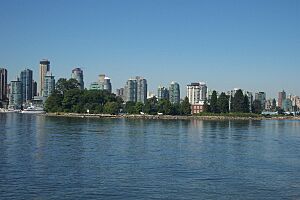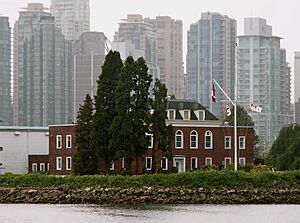Deadman's Island (Vancouver) facts for kids
Deadman Island is a small island, about 3.8 hectares in size. It's located just south of Stanley Park in Coal Harbour, Vancouver, British Columbia. The local Squamish people call it "skwtsa7s", which simply means "island." Even though its official name became "Deadman Island" in 1937, many people still call it Deadman's Island.
This island has a long and interesting past. It was once a place where battles were fought, a special burial ground for Indigenous people, and even a place where people lived during a smallpox outbreak. Today, it's home to Vancouver's Naval Reserve Division, called HMCS Discovery. The island is owned by the Department of National Defence (DND) but is leased to the City of Vancouver. However, the Musqueam Nation also has a claim to the land.
Contents
A Look Back: The Island's Past
Ancient Burial Ground
In 1862, one of Vancouver's first settlers, John Morton, explored the island. He found many red cedar boxes tied high up in the trees. One box had fallen, showing bones and hair inside. This told him the island was a special "tree-burial" ground for the Squamish people.
John Morton wanted to own the island. But Chief Capilano of the Squamish people warned him. He said the island was "dead ground" because a big battle had happened there long ago. About 200 warriors were killed in that fight between different tribes. Legend says that special "fire-flowers" grew where they fell, scaring away the enemy. This sad history is likely why the island got its name, even though the Squamish name just means "island."
Early Cemetery and Quarantine Site
Before Mountain View Cemetery opened in 1887, settlers also used Deadman Island as a burial site. Later, between 1888 and 1892, the island became a place to isolate people sick with smallpox. Those who didn't survive the illness were buried there.
The Ludgate Dispute
A Fight Over Land
The island became a place of conflict again in 1899. A man named Theodore Ludgate leased the island from the government. This made the mayor and other city officials very upset. They thought the island was part of Stanley Park.
Mayor James Garden tried to stop Ludgate from clearing the land. There was a big disagreement between Ludgate's workers and the police. Ludgate managed to avoid arrest, but police guards were left on the island. A long legal fight followed.
Island Changes Hands
During this legal battle, Ludgate went ahead with his plans. He built a sawmill and cut down all the trees on the island. He also cleared out a community of people who had been living there without permission. By 1911, Ludgate won his case.
However, Ludgate couldn't keep up with the terms of his lease. So, the island went back to the government. In 1930, the government offered the island to the city to be used as a park. But a park was never created. Instead, in 1944, it became a naval station.
Discovery is Vancouver's Naval Reserve Division. It's like a training base for naval reservists. The facility is located right on the island, helping to protect Vancouver Harbour.
This important base was used as a main operations center for big events. These included the APEC Summit in 1997 and the 2010 Winter Olympics. Besides the Naval Reserve Division, two cadet groups, RCSCC Corps 47 Captain Vancouver and NLCC Captain Rankin, also meet there weekly. The facility also has a naval museum. The island is connected to Stanley Park by a short wooden bridge, and you can even walk across at low tide.
What's Next for the Island?
The city's lease for Deadman Island from the federal government ended in 2007 but was renewed in 2008. The former mayor of Vancouver, Sam Sullivan, had ideas for the island. He imagined it could be a stop for a ferry, a maritime museum, and a place to celebrate the island's Indigenous heritage.
However, the Musqueam First Nation says the island is part of their traditional land. So, the future of Deadman Island is still being discussed. Its status remains a topic of conversation, just as it has been for much of Vancouver's history.
Images for kids







